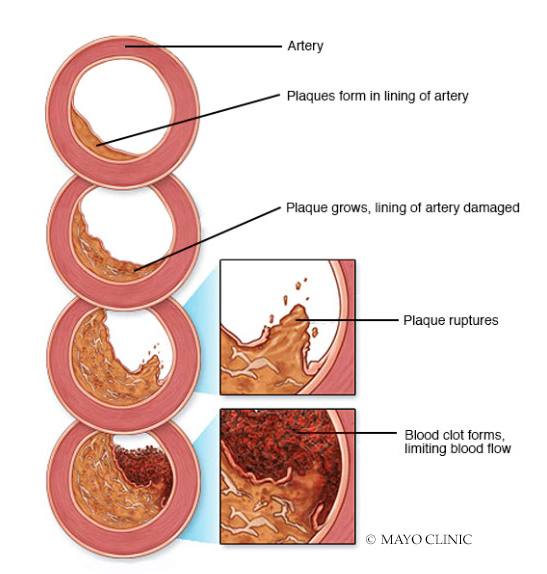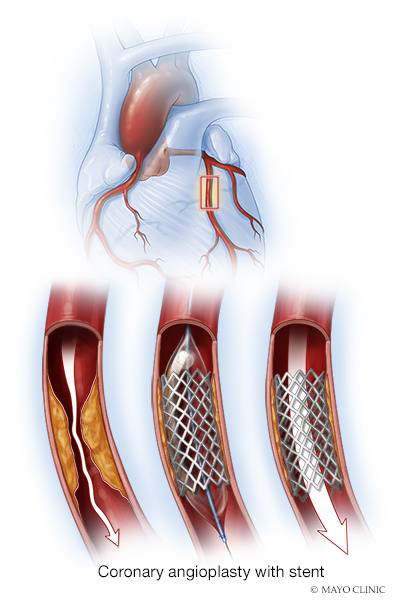
Coronary stents are placed during a procedure called coronary angioplasty (AN-jee-o-plas-tee), also called percutaneous coronary intervention, which is a procedure used to open clogged heart arteries. Angioplasty involves temporarily inserting and inflating a tiny balloon where your artery is clogged to help widen the artery.
Most stents used today are coated with a medication to help keep the artery open (drug eluting stents).
Angioplasty can improve symptoms of blocked arteries, such as chest pain and shortness of breath. Angioplasty can also be used during a heart attack to quickly open a blocked artery and reduce the amount of damage to your heart.
Watch: Animation of coronary stent placement.
Journalists: This animation of coronary stent placement is available in the downloads at the end of the post. Please "Courtesy: Mayo Clinic News Network."
Symptoms
If your coronary arteries narrow, they can't supply enough oxygen-rich blood to your heart — especially when it's beating hard, such as during exercise. At first, the decreased blood flow may not cause any coronary artery disease symptoms. As plaque continues to build up in your coronary arteries, however, you may develop coronary artery disease signs and symptoms, including:
- Chest pain (angina). You may feel pressure or tightness in your chest, as if someone were standing on your chest. This pain, referred to as angina, usually occurs on the middle or left side of the chest. Angina is generally triggered by physical or emotional stress.The pain usually goes away within minutes after stopping the stressful activity. In some people, especially women, this pain may be fleeting or sharp and felt in the neck, arm or back.
- Shortness of breath. If your heart can't pump enough blood to meet your body's needs, you may develop shortness of breath or extreme fatigue with exertion.
- Heart attack. A completely blocked coronary artery will cause a heart attack. The classic signs and symptoms of a heart attack include crushing pressure in your chest and pain in your shoulder or arm, sometimes with shortness of breath and sweating.Women are somewhat more likely than men are to experience less typical signs and symptoms of a heart attack, such as neck or jaw pain. Sometimes a heart attack occurs without any apparent signs or symptoms.

If you have too many cholesterol particles in your blood, cholesterol may accumulate on your artery walls. Eventually, deposits called plaques may form. The deposits may narrow — or block — your arteries. These plaques can also burst, causing a blood clot.
When to see a health care provider
If you suspect you're having a heart attack, immediately call 911 or your local emergency number. If you don't have access to emergency medical services, have someone drive you to the nearest hospital. Drive yourself only as a last resort.
If you have risk factors for coronary artery disease — such as high blood pressure, high cholesterol, tobacco use, diabetes, a strong family history of heart disease or obesity — talk to your health care provider. He or she may want to test you for the condition, especially if you have signs or symptoms of narrowed arteries.
Why it's done
Angioplasty is used to treat a type of heart disease known as atherosclerosis. Atherosclerosis is the slow buildup of fatty plaques in your heart's blood vessels. Your doctor might suggest angioplasty as a treatment option when medications or lifestyle changes aren't enough to improve your heart health, or if you have a heart attack, worsening chest pain (angina) or other symptoms.
Angioplasty isn't for everyone. If the main artery that brings blood to the left side of your heart is narrow, if your heart muscle is weak or if you have multiple diseased blood vessels, then coronary artery bypass surgery may be a better option than angioplasty. In coronary artery bypass surgery, the blocked part of your artery is bypassed using a blood vessel from another part of your body.
If you have diabetes and multiple blockages, your doctor may suggest coronary artery bypass surgery. The decision of angioplasty versus bypass surgery will depend on the extent of your heart disease and overall medical condition.
Stent placement
Most people who have angioplasty also have a stent placed in their blocked artery during the same procedure. The stent is usually inserted in the artery after it's widened by the inflated balloon.
The stent supports the walls of your artery to help prevent it from re-narrowing after the angioplasty. The stent looks like a tiny coil of wire mesh.

When placing a coronary artery stent, your doctor will find a blockage in your heart's arteries (A) using cardiac catheterization techniques. A balloon on the tip of the catheter is inflated to widen the blocked artery, and a metal mesh stent is placed (B). After the stent is placed, the artery is held open by the stent, which allows blood to flow through the previously blocked artery (C).
Here's what happens:
- The stent, which is collapsed around a balloon at the tip of the catheter, is guided through the artery to the blockage.
- At the blockage, the balloon is inflated and the spring-like stent expands and locks into place inside the artery.
- The stent stays in the artery permanently to hold it open and improve blood flow to your heart. In some cases, more than one stent may be needed to open a blockage.
- Once the stent is in place, the balloon catheter is removed and more images (angiograms) are taken to see how well blood flows through your newly widened artery.
- Finally, the guide catheter is removed, and the procedure is completed.
After your stent placement you will need treatment with medications such as aspirin and clopidogrel (Plavix) for at least a few months and in some patients up to 1 year.
Learn more about coronary angioplasty and stents.
This article is written by Mayo Clinic Staff. Find more health and medical information on mayoclinic.org.







